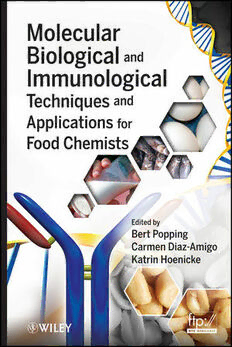
Molecular Biological and Immunological Techniques and Applications for Food Chemists PDF
Preview Molecular Biological and Immunological Techniques and Applications for Food Chemists
MOLECULAR BIOLOGICAL AND IMMUNOLOGICAL TECHNIQUES AND APPLICATIONS FOR FOOD CHEMISTS MOLECULAR BIOLOGICAL AND IMMUNOLOGICAL TECHNIQUES AND APPLICATIONS FOR FOOD CHEMISTS Bert Popping EurofinsScientificGroup Yorkshire,England Carmen Diaz-Amigo U.S. Food and Drug Administration Maryland, USA Katrin Hoenicke EurofinsWEJContaminantsGmbH Hamburg,Germany Copyright(cid:1)2010byJohnWiley&Sons,Inc.Allrightsreserved. PublishedbyJohnWiley&Sons,Inc.,Hoboken,NewJersey PublishedsimultaneouslyinCanada Nopartofthispublicationmaybereproduced,storedinaretrievalsystem,ortransmittedinanyformor byanymeans,electronic,mechanical,photocopying,recording,scanning,orotherwise,exceptaspermitted underSection107or108ofthe1976UnitedStatesCopyrightAct,withouteitherthepriorwritten permissionofthePublisher,orauthorizationthroughpaymentoftheappropriateper-copyfeetothe CopyrightClearanceCenter,Inc.,222RosewoodDrive,Danvers,MA01923,978-750-8400, fax978-750-4470,oronthewebatwww.copyright.com.RequeststothePublisherforpermissionshould beaddressedtothePermissionsDepartment,JohnWiley&Sons,Inc.,111RiverStreet,Hoboken,NJ 07030,201-748-6011,fax201-748-6008,oronlineathttp://www.wiley.com/go/permission. LimitofLiability/DisclaimerofWarranty:Whilethepublisherandauthorhaveusedtheirbestefforts inpreparingthisbook,theymakenorepresentationsorwarrantieswithrespecttotheaccuracyor completenessofthecontentsofthisbookandspecificallydisclaimanyimpliedwarrantiesof merchantabilityorfitnessforaparticularpurpose.Nowarrantymaybecreatedorextendedbysales representativesorwrittensalesmaterials.Theadviceandstrategiescontainedhereinmaynotbe suitableforyoursituation.Youshouldconsultwithaprofessionalwhereappropriate.Neitherthepublisher norauthorshallbeliableforanylossofprofitoranyothercommercialdamages,includingbutnot limitedtospecial,incidental,consequential,orotherdamages. Forgeneralinformationonourotherproductsandservicesorfortechnicalsupport,pleasecontactour CustomerCareDepartmentwithintheUnitedStatesat877-762-2974,outsidetheUnitedStatesat 317-572-3993orfax317-572-4002. Wileyalsopublishesitsbooksinavarietyofelectronicformats.Somecontentthatappearsinprintmay notbeavailableinelectronicformats.FormoreinformationaboutWileyproducts,visitourwebsite atwww.wiley.com. LibraryofCongressCataloging-in-PublicattonData: Popping,Bert. Molecularbiologicalandimmunologicaltechniquesandapplicationsforfood chemists/BertPopping,CarmenDiaz-Amigo,KatrinHoenicke. p.cm. Includesindex. ISBN978-0-470-06809-0(cloth) 1. Food–Analysis. 2. Molecularbiology. 3. Immunoassay. I. Diaz-Amigo, Carmen. II. Hoenicke,Katrin. III. Title. TX545.P672009 6640.07–dc22 2009009723 PrintedintheUnitedStatesofAmerica 10987654321 To SueHefle SueHeflewasaninternationallyrecognizedfoodscientistwithmajorcontributionsin theareaofFoodAllergyandFoodAllergenswhereshewasconsideredapioneer.She was the recipient of numerous national and international awards and because of her expertise she was member of numerous advisory panels, task forces, and working groups.DuringhercareerattheUniversityofNebraskasheworkedverycloselywiththe foodindustry,governments,andconsumerorganizations.Unfortunately,welostherin 2006attheageof46afteralongfightagainstcancer.Shefoughtthediseasewiththe same energy and positive attitude she showed during her professional career. To recognizeherhardworkandsignificantcontributionsinthefieldofFoodScienceand inparticularFoodAllergens—somethingshedidwithpassion—wearededicatingthis booktoSue,ourfriendandcolleague. CONTENTS CONTRIBUTORS xi PREFACE xiii PART Ia MOLECULAR BIOLOGICAL METHODS: TECHNIQUESEXPLAINED 1. Molecular Biology Laboratory Layout 3 RainerSchubbert 2. Polymerase Chain Reaction 41 HermannBroll 3. Quantitative Real-Time PCR 59 HermannBroll 4. Polymerase Chain Reaction–Restriction Fragment Length Polymorphism Analysis 85 KlausPietschandHans-UlrichWaiblinger 5. Single-Stranded ConformationPolymorphism Analysis 105 HartmutRehbein 6. Sequencing 119 RainerSchubbert PART Ib MOLECULAR BIOLOGICAL METHODS: APPLICATIONS 7. Meat 135 InesLaube 8. Genetically Modified Organisms 157 BertPopping vii viii CONTENTS 9. Detectionof Food Allergens 175 CarmenDiaz-AmigoandBertPopping 10. Offal 199 NeilHarris 11. Aquatic Food 209 HartmutRehbein PART IIa IMMUNOLOGICALMETHODS: TECHNIQUES EXPLAINED 12. Antibody-Based Detection Methods: FromTheory to Practice 223 CarmenDiaz-Amigo PART IIb IMMUNOLOGICAL METHODS: APPLICATIONS 13. Animal Specification inSpeciation 249 BruceW.RitterandLauraAllred 14. InternationalRegulatory Environment for Food Allergen Labeling 267 SamuelBenrejebGodefroyandBertPopping 15. Japanese Regulations and Buckwheat Allergen Detection 293 HiroshiAkiyama,ShinobuSakai,ReikoAdachi,andReikoTeshima 16. Egg Allergen Detection 311 MasahiroShoji 17. Soy Allergen Detection 335 MarcelloGattiandCristinaFerretti 18. Milk Allergen Detection 349 SabineBaumgartner 19. Gluten Detection 359 UlrikeImmerandSigridHaas-Lauterbach 20. Nut Allergen Detection 377 RichardFielder,WarrenHiggs,andKatieBarden 21. Fish Allergen Detection 407 ChristianeKruseFæste 22. Lupin Allergen Detection 423 ChristianeKruseFæste CONTENTS ix 23. Mustard Allergen Detection 445 AnneE.RyanandMichaelS.Ryan 24. Celery Allergen Detection 451 CharlottaEngdahlAxelsson INDEX 459 CONTRIBUTORS ReikoAdachi, DivisionofNovelFoodsandImmunochemistry,NationalInstituteof Health Sciences,Tokyo,Japan Hiroshi Akiyama, Division of Novel Foods and Immunochemistry, National Institute of Health Sciences, Tokyo, Japan Laura Allred, ELISATechnologies,Inc., Gainesville,Florida Charlotta Engdahl Axelsson, Eurofins Food & Agro Sweden AB, Ldink€oping, Sweden Katie Barden, Tepnel Research Products and Services, Deeside Industrial Park, Flintshire, UK Sabine Baumgartner, Center for Analytical Chemistry, University of Natural Resources andApplied Life Sciences,Tulln, Austria Hermann Broll, Bundesinstitut f€ur Risikobewertung, Berlin, Germany CarmenDiaz-Amigo, CenterforFoodSafetyandAppliedNutrition,U.S.Foodand Drug Administration, Maryland, USA Christiane Kruse Fæste, National Veterinary Institute, Oslo, Norway Cristina Ferretti, Microbiotech Department, NeotronS.p.a.,Modena, Italy RichardFielder, TepnelResearchProductsandServices,DeesideIndustrialPark, Flintshire, UK Marcello Gatti, Microbiotech Department, Neotron S.p.a., Modena, Italy SamuelBenrejebGodefroy, FoodDirectorate,HealthProductsandFoodBranch, Health Canada, Ottawa,Ontario,Canada Sigrid Haas-Lauterbach, R-Biopharm AG,Darmstadt, Germany Neil Harris, LGC Limited,Teddington,Middlesex,UK Warren Higgs, Tepnel Research Products and Services, Deeside Industrial Park, Flintshire, UK Katrin Hoenick, EurofinsWEJ Contaminants GmbH,Hamburg, Germany Ulrike Immer, R-Biopharm AG,Darmstadt, Germany xi xii CONTRIBUTORS Ines Laube, Institut f€ur Lebensmitteltechnologie und Lebensmittelchemie, Technische Universit€at Berlin, Berlin, Germany Klaus Pietsch, Chemisches und Veterin€aruntersuchungsamt Freiburg, Freiburg, Germany Bert Popping, EurofinsScientificGroup, Pocklington, Yorkshire,UK HartmutRehbein, Max Rubner-Institut,Hamburg,Germany Bruce W.Ritter, ELISATechnologies,Inc., Gainesville, Florida Anne E. Ryan, ELISA Systems Pty. Ltd., Brisbane, Queensland, Australia Michael S. Ryan, ELISA Systems Pty. Ltd., Brisbane, Queensland, Australia ShinobuSakai, DivisionofNovelFoodsandImmunochemistry,NationalInstitute ofHealth Sciences, Tokyo,Japan Rainer Schubbert, EurofinsMedigenomix GmbH,Ebersberg,Germany MasahiroShoji, MorinagaInstituteofBiologicalScience,Inc.,Yokohama,Japan ReikoTeshima, DivisionofNovelFoodsandImmunochemistry,NationalInstitute ofHealth Sciences, Tokyo,Japan Hans-Ulrich Waiblinger, Chemisches und Veterin€aruntersuchungsamt Freiburg, Freiburg, Germany PREFACE Fromahistoricalpointofview,theanalysisoffoodisperformedpredominantlyusing typicalchemicalorphysicochemicalmethods.Theseare,forexample,wetchemical methods for proximity analysis or chromatographic methods for the analysis of pesticides and veterinary drug residues. In addition, food chemists use such physics-basedmethodsasviscositymeasurementandatomicabsorptionspectroscopy for theanalysis of heavy metals. Foodchemistsingeneraltendtohavegoodknowledgeinsomeareasofbiological analysis: in particular, regarding methods for the detection and enumeration of microorganisms and enzymatic methods for the analysis of single sugars or nitrite/ nitrate.Inthepast,useofthesemethodswassufficientforcompliancewithregulations andforqualityassuranceoffood.However,inrecentyearsseveralnewissueshave ariseninthefieldoffoodanalysiswhichcannotbesolvedsimplybyapplyingchemical methods. Companies and regulators alike now have higher demands for safer food and productquality.Thisisreflectedinmorestringentcustomerproductspecificationsas wellasnewregulationsissuedacrosstheworld.Anexampleisanallergen-labeling regulationintroducedintheUnitedStatesonJanuary1,2006.Similarregulationswith an expanded scope have come into force in Europe and, some years ago, in Japan. Anotherexampleistheintroductionofregulationsforthelabelingandtraceabilityof genetically modified organisms. Although at present these are not regulated in the United States, regulations exist in Europe, Japan and other Asian countries, and in other parts of theworld. Otherregulationscovertheprotectionofconsumersfromdeceptionbymislabeling or adulteration of products. Examples are the adulteration of mandarine/tangerine juice, mislabeling of premium products such as Angus beef, and the protection of ethnic minorities from eating products forbidden by their religion. These analytical challenges can be solved easily using methods based on molecular biological or immunological principles: polymerase chain reaction (PCR), real-time PCR, and restriction fragment length polymorphism, or in the immunological field, enzyme- linked immunosorbent assay and dotand Westernblot,to name but afew. Forthetypicalfoodchemistthistendstobeagenerallynewfield,sincemolecular biologicalandimmunologicalmethodsarebasedonotherprinciples.Butespecially over the past few years, borderlines between biological and physicochemical tech- niques have moved and fields previously separate have amalgamated somewhat as techniqueshavebeencombinedtomakeitpossibletoprovideanswersfasterandmore xiii
